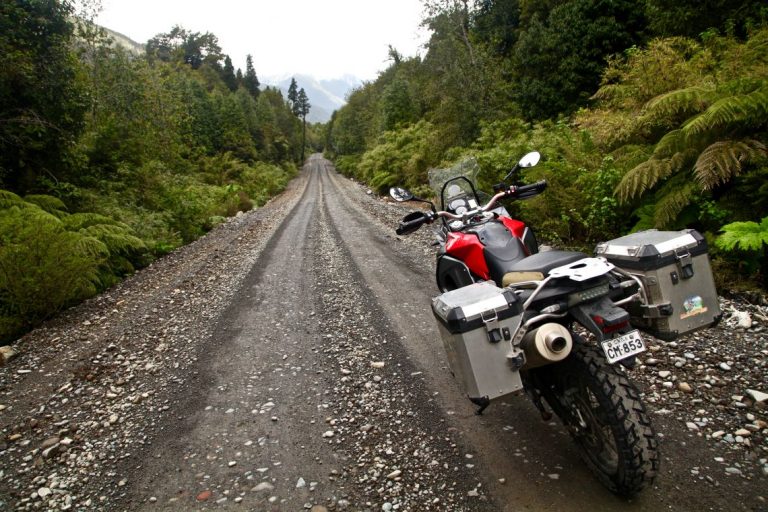Ian Neubauer heads to Chile to ride the wild and beautiful Austral Highway
Founded by German migrants in the 1850s, the Chilean city of Puerto Montt is known for two things. The first is Salmon aquaculture; after Norway, Chile is the biggest exporter of farmed salmon in the world and Puerto Montt is the industry’s epicentre.
The second is for being the starting point of the Austral Highway, A.K.A. the road after the end of the road because it starts close to where Pan-American Highway ends. Constructed in the 1970s by the military regime of General Augusto Pinochet over fears of an Argentinian invasion, the 770-mile thoroughfare transverses Chile’s Patagonia region; a rugged, sparsely populated, nearly untouched rift of fjords, valleys, mountains massifs, glaciers, ice fields, rainforests, marshlands and high coastal cliffs.
The logistical challenges of laying the road were such that the gravel version took a decade to build, and attempts to pave it from end-to-end continue this day. Yet one thing keeps on getting in the way; rain.
Six bloody metres of it each year – a fair chunk of which seemed to fall during my first two days in Chile as I waited for the weather the clear so I could begin my north-to-south navigation of Austral Highway. So, I waited… And waited… And waited until I could wait no more.
“Where you are going is the purest of the world, of life, la pacha mama (mother earth),” my taxista tells me en route to MotoAventura, an accredited BMW Motorrad rental company in Osorno, just north of Puerto Montt, where I’m picking up a bike. “You will not regret your journey, no matter how much it rains.” A bold claim.
Puerto Montt to Caleta Gonzalo
The first section of the Austral veers south-west from Puerto Montt along a windswept coast that rises sharply towards long rows of peaks – first green and then white snow-covered summits that play hide-and-seek with the clouds.
After only 30 miles, the highway comes to a dead-end at Punta Arenas, where a deep channel edged by cliffs, part of a long fjord bisecting the highway, tells travellers this is as far as they can go. Pinochet’s engineers solved the problem, not with a mega-bridge that would have cost billions, but fast and efficient vehicle ferries.
Two minutes after I arrive, a ferry turns up and I’m waved on board. But cast aside any preconceptions of your writer relaxing above deck with a chilled cerveza (beer) in his hand. The ride across the channel is so rough I must spend it in the cargo hold counter-balancing my bike to keep it upright.
There’s a short but much-appreciated respite in the rain during the next section of road – a wet trail that cuts through a rainforest with that post-rain smell in the air. After 30 miles or so it pops me out onto a bluff overlooking the roughshod town of Hornopirén.
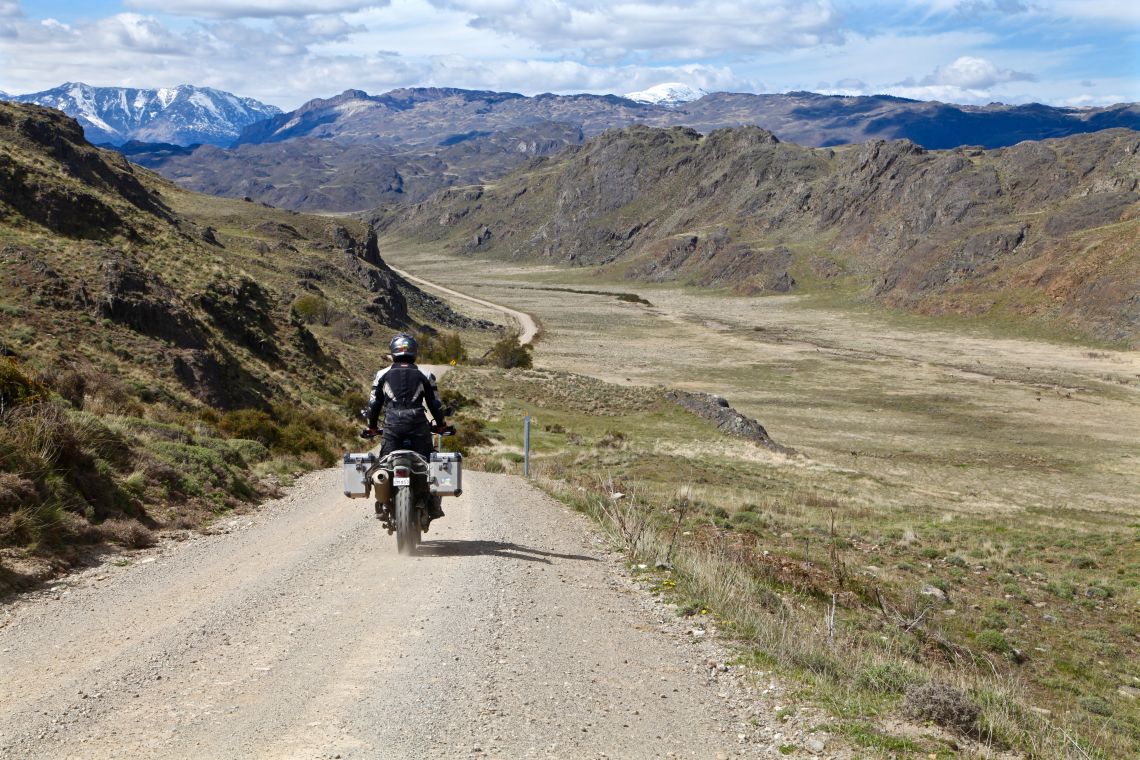
Set precariously under a colossal snow-capped volcano, Hornopirén marks the start of another fjord and yet another natural dead-end for the Austral Highway. But unlike the previous fjord, which intersected the highway, this fjord runs parallel to it for 37 whole miles, and the only way across it is on a slow and lengthy five-hour ferry that leaves once daily at 10 am.
Originally, I’d planned to spend the night at Hornopirén. But when I reach the ferry terminal at 7 pm to buy a ticket for the next day’s ferry I meet three Argentinian riders – Carlos, Jose Luis and Nesto. They tell me they’d been waiting for the morning ferry all day, but rough seas had prevented it from docking until a few moments ago.
Not wanting to suffer the same fate, I buy a ticket on the spot, hop aboard and park my Beemer alongside the other guys’ bikes. They use ropes to fasten their machines to mounting hooks on the deck and offer to do the same to mine so I don’t have to spend the next five hours trying to keep it upright.
And just like that, I’ve got a new set of mates. They tell me heaps of interesting stories about riding through South America, like a time in Brazil when the coppers confiscated all their bikes over a minor infraction and refused to give them back until the media got involved. And how, in Bolivia, they had to pay a local to buy fuel on their behalf because the gas stations won’t sell it to tourists.
It’s midnight when we disembark at the next ferry stop, and it’s raining heavily. This section of the Austral is a no man’s land. A muddy six-mile track through a heavily forested peninsula that leads to the third and final car ferry.
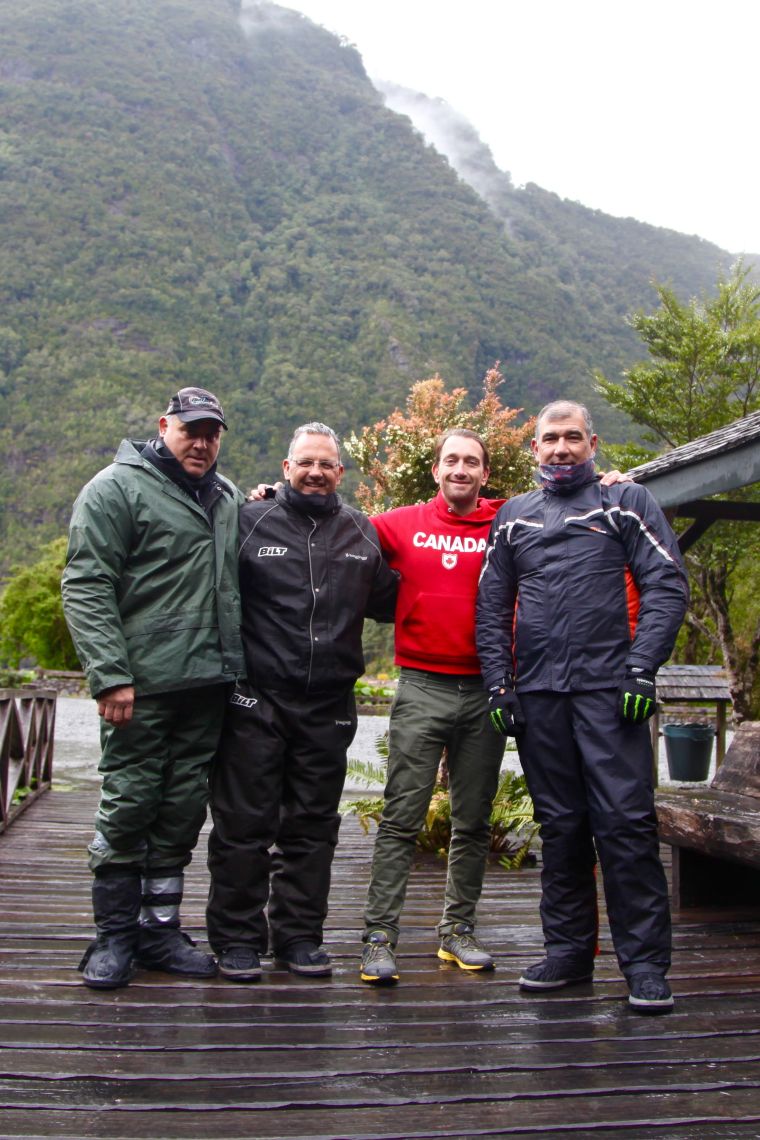
The other passengers aboard our ship jump into warm comfy cars or the courtesy minibus for the transfer. Us riders, however, get soaked to the bone. A few moments after reaching the next ferry terminal, the rain abruptly stops. But the moment we dock at Caleta Gonzalo, it starts again, heavier than ever.
It’s now 2 am. The closest town, Chaitén, is 40 miles away, and we want to keep on riding like Nigel Farage wants a halal butcher to open in his neighbourhood. But there’s a small lodge adjacent to the ferry dock and, luckily, they have one vacant cabin.
It’s tiny and only has two beds, but we make the best of it, using our clothes and towels and a few blankets to create a big swag on the floor so everyone can get a good night’s sleep. One by one, we pass out to the sound of torrential rain drumming against the roof and windowpanes.
Caleta Gonzalo to Villa Santa Lucia
The rain doesn’t stop all night and, when we wake up to more of it, the Argentinians call it quits. Shortly after daybreak, they pack their bags and head west to the nearest border crossing in hope that the Andes Mountains might shield them from the Pacific rain.
As for me, I spend the morning enjoying a long, lazy cooked breakfast beside a fireplace in the lodge’s rustic dining room.
At one point my serenity is disturbed by a group of loudmouth Americans travelling on a National Geographic-branded cruise ship moored in the fjord. They go on and on about their cute little adventures on the walking trails of Pumalin National Park, how they saw a volcano or a bird or whatnot.
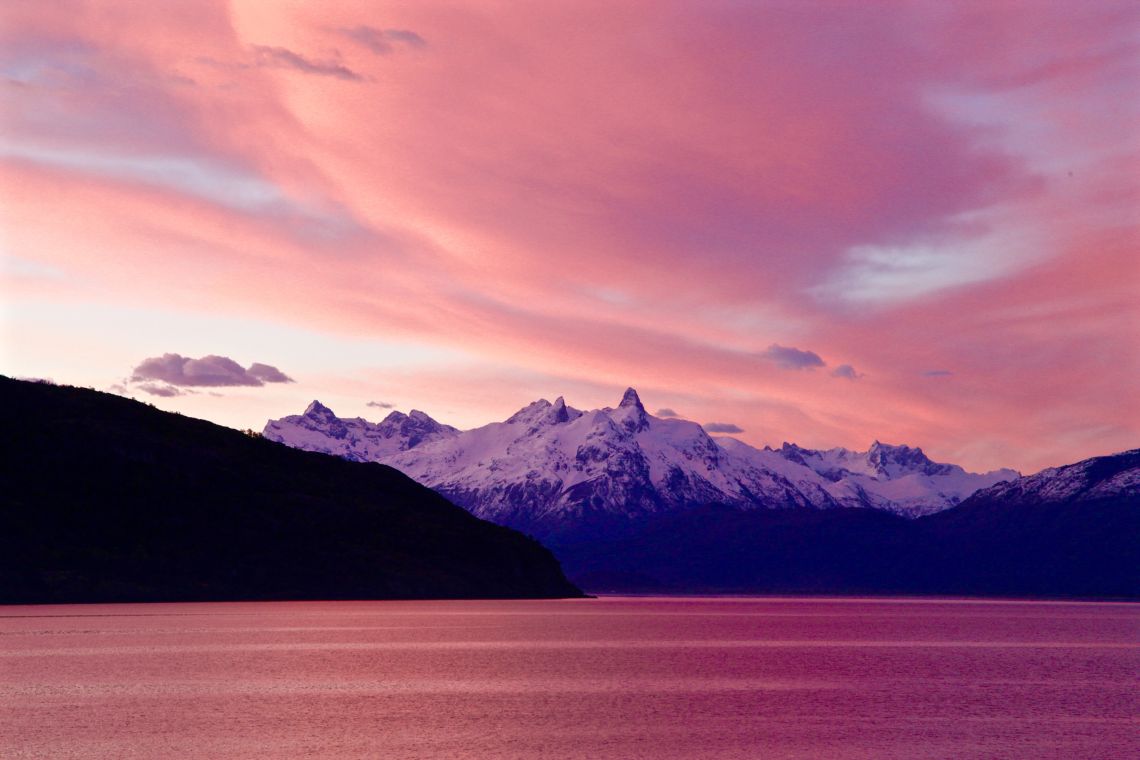
It’s great that they’re seeing the world, but most of them will never know the feeling of real adventure, of being alone on a motorbike and 800cc of German grunt in a foreign land with nothing but one’s wits, a map and an error-prone GPS to guide them.
It’s 2 pm when the clouds finally clear and a rainbow appears over the fjord. A sign, if I ever saw one, to ride like the wind. I spend the next two to three hours charging along a muddy track bordered by exotic plants with two-metre-wide leaves and 3,000-year-old endangered Alcerces hardwood trees.
The mist comes and goes like spirits, exposing distant hills and ridges. Condors fly overhead in slow, concentric circles. It’s a magical, mystical, otherworldly place and I never want it to end.
At 6 pm I reach Chaitén, a town cut straight out of a spaghetti western with Spanish subtitles. On May 3, 2008, Mount Chaitén erupted for the first time in 9,500 years. Lava flow changed the course of the Chaitén River and sent it gushing through main street, destroying half the town, while what remained was ruined by tonnes of settling ash. Eight years later have passed and Chaitén still looks like a mining site – a place people can’t bother getting attached to.
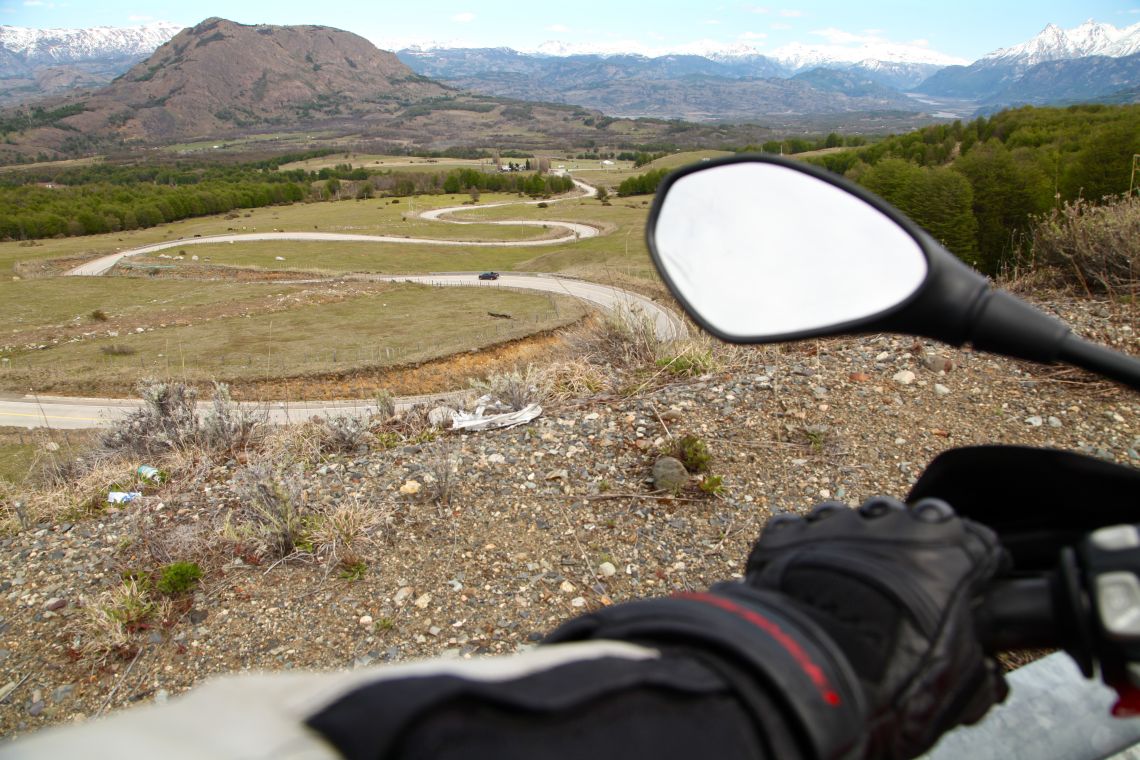
I stop off at a shabby wooden store, grab a couple of hot empanadas (homemade beef and onion pies) and zoom off again. They say in Patagonia that ‘if you hurry, you lose time’ but I just can’t help myself. Faster and faster and faster I go, arching into peg-threatening leans around corners and punching it in sixth gear on long desolate straights that cut through a land lying outside of time and all the trivial, irrelevant bullshit that keeps me up at night back home.
Even the rain, when it returns, doesn’t bother me. Like the Mapuche Indians, Welsh miners, German graziers and Romanian missionaries who tried to tame this strange land, Patagonia, it seems, is having a transformative effect on me. When I finally stop for the night at the town of Villa Santa Lucia at 8 pm, I only do so because it’s getting dark. Otherwise, I could ride like this forever.
After a lukewarm shower, I eat my empanadas, smash back a few glasses of wine and slide into bed.
There’s a message on my phone from the Argentinians:
“Hi brother, hope you are well. We are back in Argentina, but it’s raining here, too! Hope you are dry and safe. Come visit us soon.”
Villa Santa Lucia to Puerto Chacabuco
Yes, it’s bloody raining again when I wake up today, but less heavily than on previous days. At first light, I’m back on the road, a narrow and lonesome stretch of dirt kisses by hundreds of waterfalls where I refill my drinking flask with the coolest, sweetest, purest on earth.
I also see an increasing number of road workers hacking, chipping, reshaping and sealing dirt road, and pass a sign that indicates this section of the Austral Highway will be completely paved by mid-2017. I’m glad to have seen it now it in its more raw, elemental state because the improvements are sure to increase tourism numbers exponentially.
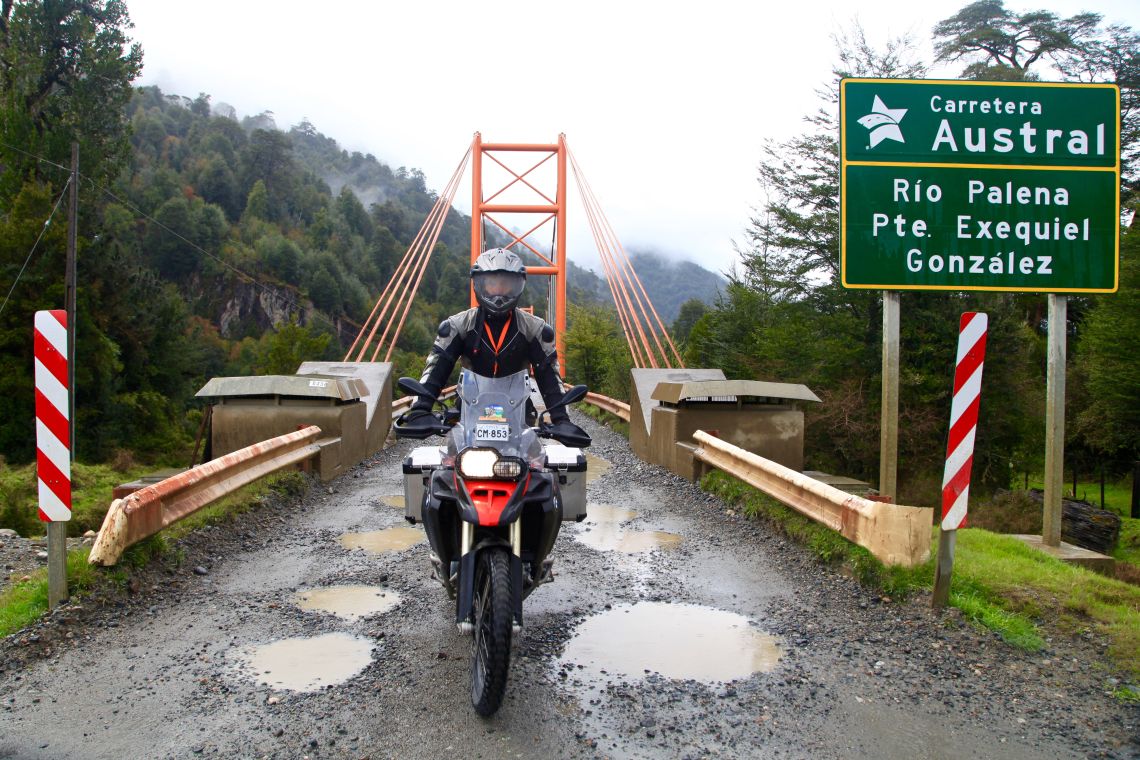
At 1 pm, I reach Puyuhuapi, a sheltered waterfront town founded by German migrants. With A-frame houses backdropped by snowy peaks, it looks like a set out of The Sound of Music. I heard there’s a massive glacier that literally hangs between a gap in the mountains 12 miles inland from here, but I have no time for such distractions.
Extensive roadworks are taking place over a 30-mile stretch of gravel on the outskirts of Puyuhuapi and the road closes each day from 1:30 pm-5:30 pm. I’m one of the last vehicles waved through before the roadblock is put up and all traffic stops for four hours.
From Puyuhuapi, the road curls like a serpent on a ledge sandwiched between a long finger of sea and towering granite cliff s that is basically one enormously wide waterfall. Wherever I look I see something beautiful: forests, mountains, raging rivers or jagged snow-capped peaks.
Later in the day I also see something I’ve not seen on this trip yet; blue skies! Not just a brief respite in the clouds, but a perfect blue sky that stretches as far as the eye can see. If Patagonia was impressive before, in the sun it’s like a fairytale. It’s hard to believe a place as beautiful as this really exists.
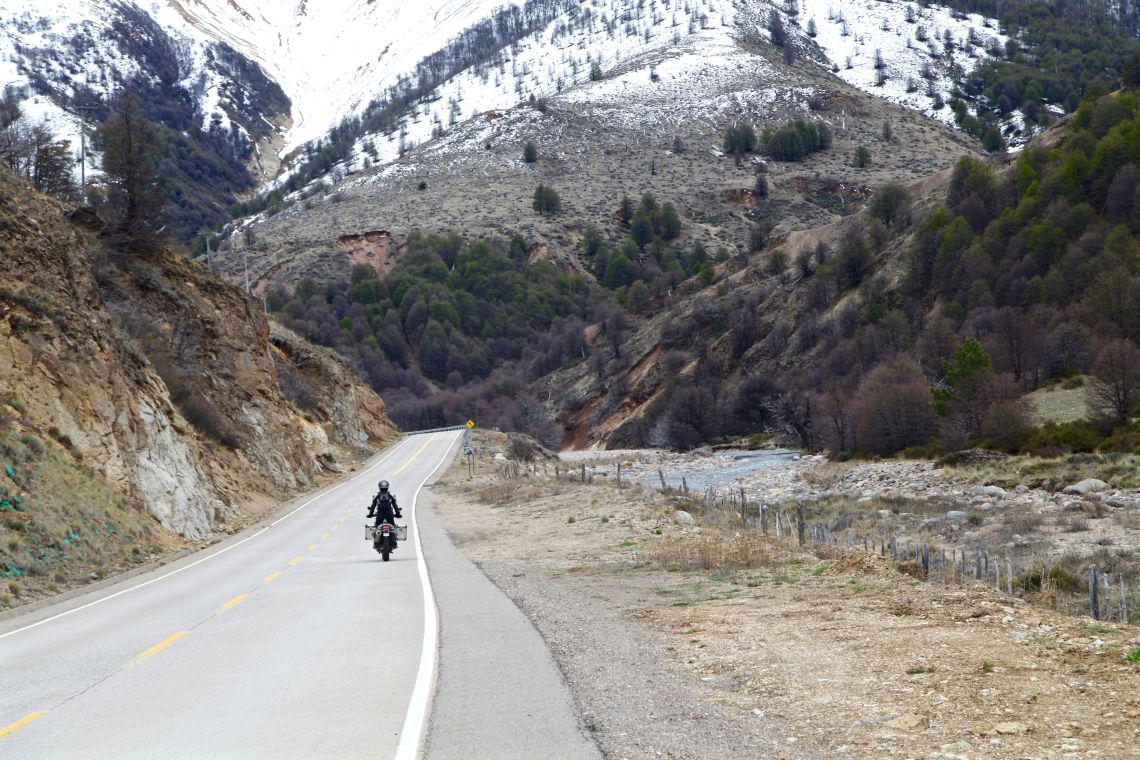
My destination for the evening is Puerto Chacabuco, a town set on a soaring cliff overlooking Aysen Fjord where I’m shouting myself a night at a fancy hotel called Loberias Del Sur. In fact, I’m shouting myself two nights because I’ve booked a boat tour to see the San Rafael glacier the following day.
At 7 am I assemble in the lobby with another 50-odd tourist for a short bus ride to the port. There we board a high-speed catamaran for a five-hour cruise past islands, channels and fjords until we reach a river that leads to San Rafael Lagoon. Inside, it is like Antarctica, a semi-frozen world where ice flows (chunks of bright blue ice that bob up and down the water) float on by.
The chunks get bigger and bigger as we inch forward and soon they’re not chunks – they’re icebergs bigger than our bloody boat! And there in the distance is Superman’s Palace, a 350m wide glacier wall shining like a giant diamond. After a champagne lunch on the deck, we split up into small groups for a zodiac ride to get us as close as possible to the ice wall, which on this day is only 500m. Ice-flows can and do break off at any given moment. And when they break, it sounds like the world is being torn in two. Awesome!
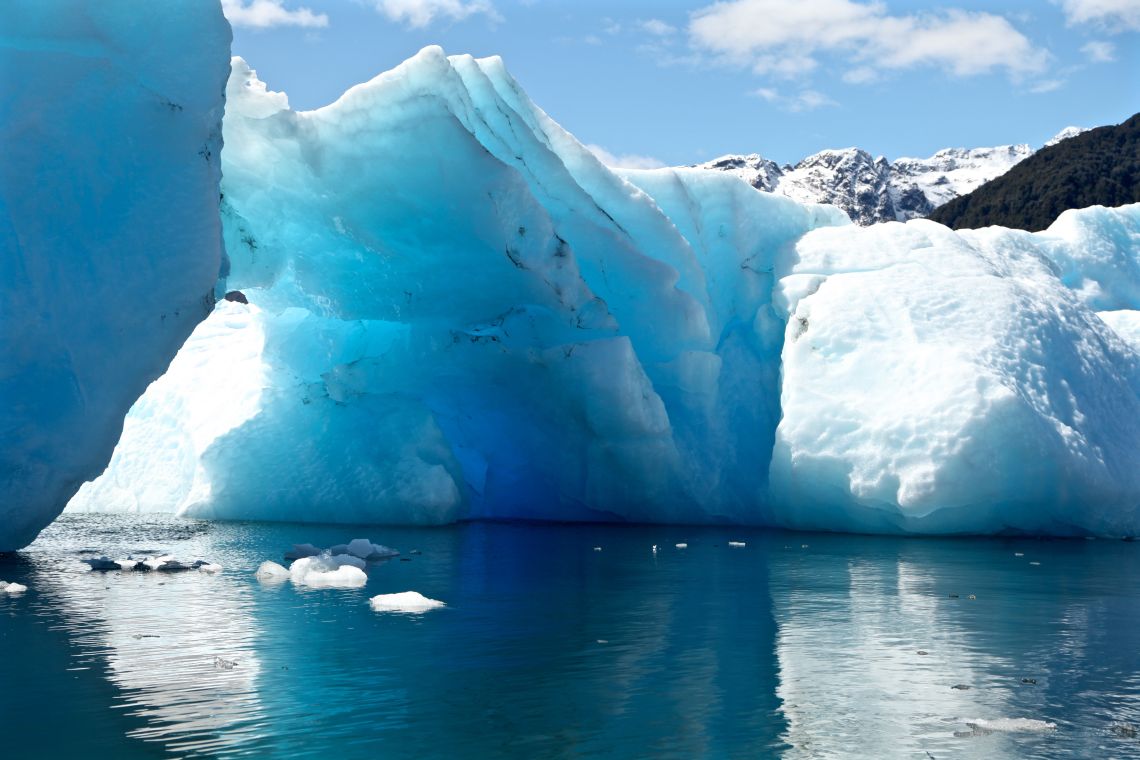
I assumed the five-hour steam back to Puerto Chacabuco would be a boring affair, but in Chile moments of idle are just an excuse to party. The captain announces the bar is open and, as a treat, they’re giving away 40-year-old Scotch whisky served on chunks of 20,000-year-old glacier ice. Then the karaoke machine is switched on and everyone, including the gringos (foreigners), has a go singing corny Spanish ballads.
More drinks and more food are served, the hours pass effortlessly and before we know it we’re back at the hotel, half-drunk and with a new bunch of friends, though I don’t remember any of their names, except for Murray, a guy from my hometown Sydney who, in true Aussie style, got sunburnt and absolutely smashed on the free drinks and who probably doesn’t want to be mentioned in my story, at least not in that way.
Puerto Chacabuco to Puerto Guadel
I wake up to the most beautiful sound in the world; nothing! The sky is clouded over but I can’t feel a drop of rain. After wolfing down a hot breakfast, I hit the road, zooming along a long narrow straight to Coyhaique, a city with a population of 50,000, the last sizeable settlement this far south in Chile. On the outskirts, I get pulled over by the coppers. Unlike other parts of South America, the police in Chile are squeaky clean. They don’t ask for a cash donation, only to check my license and rego, before sending me on my way.
The temperature plummets to two degrees Celsius as I head further south, and I start losing all feeling in my toes. I see snow on the side of the road, first a few patches here, and then more and more until suddenly I find myself riding through a winter wonderland where the mountains, until now distant, practically touch the road.
I hit a series of tight switchbacks that climb to a 1,000m pass that is the highest point on the Austral Highway where I’m rewarded with an in-your-face view of Cero Castillo (Castle Mountain). It was named as such because of the 2,700m high turrets and spires jutting out of its peak, though I think it looks more like an evil stone claw reaching out from the earth than a castle.
After the pass, the road drops like a bomb into a vast, wide plain where the clouds clear, the sun comes out and the temperature rises sharply to 15 degrees. For the first time on this journey I pull over at a little village, take off my riding jacket and sit in the sun. It’s a glorious feeling, drinking in the Vitamin D and the view of that crazy claw of a mountain, along with a sneaky cerveza, which I really deserve.

The further south I drive, the more epic the scenery becomes. It’s so big, so picturesque, that attempting to describe it becomes an act in futility and photos can’t do it justice at all. Late, in the afternoon, just when I think I’ve seen it all, I hit a wild zig-zag that descends to the cliff-lined shores of Lago General Carerra.
The general consensus is that the water is turquoise in colour, but it’s so much ‘bluer’ than that. It’s a super-blue, like a blue lightsaber. And if the colour wasn’t impressive enough, the lake is so damn big I can’t see the other end. Measuring 105 miles from east to west, it’s the second biggest lake in all South America.
At the town of Rio Tranquilo I fill up with fuel, buy some empanadas and get ready for the final 40-mile run of the day. The road, an orgy of switchbacks, turns and curves spits me onto an arm – a natural bridge crossing the lake. At this point, I say goodbye to the Austral Highway, which continues 155 miles south to Villa O’Higgins. Instead, I veer east along a dirt road that leads to the Argentinian border and my next adventure, which was featured in the last issue of ABR.
I spent my final night in Chile in the village of Puerto Guadal, where I’ve booked a night at a biker-friendly lodge called Terra Luna. The owner, a Frenchman called Philippe, puts me up in a boathouse. Not a houseboat but a boat set on stilts on the beach with a bathroom, little dining table and even a bloody fireplace inside! After a hot shower, I sit on the deck and munch on empanadas washed down with more Chilean wine. The sunsets slowly over a sawtooth ridge, turning the lake from blue, to pink, to orange before settling on a fiery shade of red.
I’ve had the privilege of riding many of the world’s most iconic designated highways: the Icelands Parkway in Canada, to the Highlands Highway of Papua New Guinea and Cape York’s Peninsula Development Road. They were all brilliant in their own right, but the Austral Highway, well it’s simply better, bigger, grander, emptier and more remote – an unforgettable, visually explosive journey through one of the last true strongholds of nature on Earth. See it now, before it changes, but come prepared for the rain.
Motochamp Chile
Some 190 miles from Puerto Montt, in the resort town of Pucon, is MotoCamp Chile (www.motocamp.cl) – the world’s first fully-integrated motorbike resort in that it combines a lodge, campsite, function centre, restaurant, bar and repair shop in one. The owner, Cristian Maragaño, describes it as “a paradise for bikers where like-minded travellers can make new friends, share stories about where they’re going and where they’ve been… where every guest is both a teacher and student.”
Renting a Bike
There are a dozen-odd companies in Chile that rent high-end adventure bikes. So why did I choose MotoAventura? Two reasons. First, because they’re based in Osorno, an hour’s drive from the start of the Austral Highway at Puerto Montt, whereas most of the other companies are based in the capital Santiago. And second, as official BWM Motorrad partners, MotoAventura’s bikes must be replaced at least every two years so they are always in top nick. My F800GS was flawless. See www.motoaventura.cl for more information.

